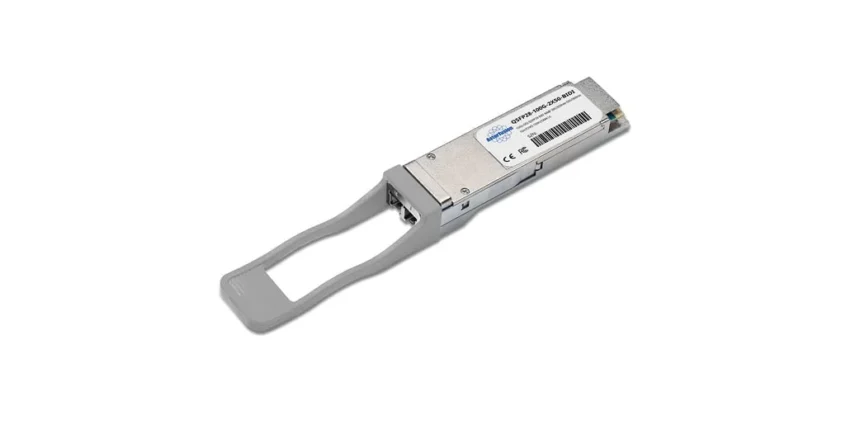As the demand for faster, more reliable data transmission continues to grow, network infrastructure is evolving to meet these needs. High-capacity optical modules, particularly 100G BiDi QSFP28 optical modules, are becoming essential for optimizing data center interconnects, metro networks, and long-distance communications. By providing high-speed connectivity with a reduced need for fiber infrastructure, 100G BiDi QSFP28 modules are poised to reshape the landscape of modern networks. In this article, we will explore what 100G BiDi QSFP28 optical modules are, their key benefits, and why they are crucial for modern, high-capacity networking environments.
What Are 100G BiDi QSFP28 Optical Modules?
A 100G BiDi QSFP28 optical module is a high-performance optical transceiver designed to deliver 100G of data bandwidth over a single optical fiber using bi-directional (BiDi) transmission. Unlike traditional optical modules that require separate fibers for transmitting and receiving data, BiDi modules use two different wavelengths on the same fiber for sending and receiving signals. This technology maximizes fiber utilization, reducing the need for additional cables and enabling faster, more cost-efficient network infrastructure.
The QSFP28 (Quad Small Form-factor Pluggable 28) designation indicates the module’s physical form factor and its support for 100G data rates. These modules are designed to meet the demands of high-speed, high-density networks, making them ideal for applications in data centers, metro networks, and enterprise backbones. They come in various configurations, such as single-mode and multi-mode, to suit different network types and distances.
Key Benefits of 100G BiDi QSFP28 Optical Modules
Maximizing Fiber Efficiency
The primary advantage of 100G BiDi QSFP28 modules is their ability to maximize fiber utilization. Traditional optical modules typically require two separate fibers for transmission and reception, but BiDi modules can transmit and receive signals over a single fiber. This dual-wavelength technology allows operators to double the available bandwidth on each fiber without the need to lay additional cables.
For networks operating in dense environments, such as metropolitan areas or large data centers, reducing the number of fibers used can result in substantial savings in terms of both material costs and physical space. Additionally, it lowers the complexity of managing cables and infrastructure.
Cost-Effective Deployment
With 100G BiDi QSFP28 modules, network operators can achieve significant cost savings. By eliminating the need for multiple fibers for each connection, companies can reduce the overall cost of fiber optic infrastructure. This is particularly beneficial for metro networks, where high-density fiber deployment is often required to keep up with growing demand for bandwidth.
Moreover, BiDi technology enables the use of existing infrastructure for increased capacity without requiring extensive rewiring or fiber installation. As businesses scale their networks, they can simply add more wavelengths to the existing fibers, avoiding costly new fiber optic installations and facilitating quicker deployments.
Simplifying Network Management
Managing large, complex networks often involves juggling multiple cables and ensuring that each connection is functioning properly. With 100G BiDi QSFP28 modules, the overall complexity of network management is greatly reduced. By requiring only a single fiber for bidirectional communication, these modules reduce the number of physical connections that need to be monitored and maintained.
For network administrators, this simplicity translates into easier troubleshooting, faster deployment, and lower ongoing maintenance costs. The ability to manage fewer cables also reduces the risk of human error during installation and improves overall network reliability.
Enhanced Scalability
In today’s fast-evolving network environments, scalability is essential. Networks need to be flexible and able to adapt to increasing data traffic and new technologies without extensive overhauls. 100G BiDi QSFP28 modules enable scalability by offering a simple and efficient way to increase network capacity.
As demand for bandwidth increases, operators can easily add more wavelengths to the existing fiber infrastructure, increasing data rates without the need for additional fibers. This ability to scale incrementally ensures that networks remain future-proof, with minimal disruption to ongoing operations.
Supporting High-Capacity Applications
As cloud computing, high-definition video streaming, and real-time communications continue to grow, the demand for higher bandwidth is pushing network infrastructure to its limits. 100G BiDi QSFP28 modules are specifically designed to handle the large data flows required by these high-capacity applications.
These modules provide low-latency, high-speed connectivity ideal for data-intensive applications in environments such as data centers, cloud computing platforms, and video broadcasting. Whether it’s for interconnecting data centers, supporting 5G backhaul, or enabling enterprise network connectivity, 100G BiDi modules are capable of supporting the most demanding bandwidth-intensive workloads.
Applications of 100G BiDi QSFP28 Optical Modules
Data Center Interconnects
Data centers rely heavily on high-speed, reliable interconnects to link servers, storage, and networking equipment. 100G BiDi QSFP28 modules play a critical role in improving the efficiency of these interconnects, providing high-bandwidth, low-latency connections over a single fiber.
In modern data center designs, minimizing cable usage is essential for reducing costs and increasing density. By using BiDi modules, data centers can achieve greater network capacity while conserving space and cutting down on fiber-related expenses. This is especially important as data centers grow to accommodate more users and more complex workloads.
Metro Networks and Service Providers
Metro networks, which connect multiple cities or regions within a metropolitan area, must deliver high-capacity, low-latency connections to ensure seamless communication and service delivery. 100G BiDi QSFP28 modules are perfect for these networks, as they provide high-speed connections with reduced fiber requirements.
For Internet Service Providers (ISPs) and telecom operators, 100G BiDi modules offer a cost-effective means of scaling bandwidth while utilizing existing fiber infrastructure. Whether it’s for expanding regional networks or providing interconnects between different locations, 100G BiDi QSFP28 modules are a key component in building efficient, high-performance metro networks.
Long-Distance, High-Capacity Links
Long-distance networks, such as those used for cross-country or intercontinental communication, require both high capacity and low latency. The ability of 100G BiDi QSFP28 modules to support 100G data rates over a single fiber link makes them ideal for such applications. By reducing fiber usage and increasing capacity, BiDi modules help service providers achieve long-distance connectivity more efficiently.
Additionally, these modules can be used to support connections between regional data centers, allowing businesses to establish low-latency, high-speed links across vast distances.
Comparing 100G BiDi QSFP28 to Traditional Multi-Fiber Solutions
One of the most significant advantages of 100G BiDi QSFP28 modules is their ability to carry bidirectional data over a single fiber. This stands in contrast to traditional 100G QSFP28 modules, which require separate fibers for transmitting and receiving data. The BiDi approach cuts fiber usage in half, making it a more efficient solution for network operators.
Moreover, traditional multi-fiber solutions often come with additional complexity in terms of cable management, installation, and maintenance. 100G BiDi modules streamline these processes, allowing for easier deployment and reducing overall operational costs.
Conclusion
As the demand for faster, more reliable data transmission grows, QSFP28 100G BiDi modules have become a crucial part of the modern networking landscape. By maximizing fiber efficiency, reducing deployment costs, simplifying network management, and supporting high-capacity applications, these modules provide a comprehensive solution for meeting the needs of high-speed, high-density networks. From data centers to metro networks and long-distance connections, 100G BiDi QSFP28 modules are helping operators future-proof their networks, ensuring scalability and efficiency as the digital world continues to evolve. As the networking industry continues to prioritize performance and cost-efficiency, 100G BiDi QSFP28 optical modules will undoubtedly play a central role in shaping the future of high-capacity communications.








